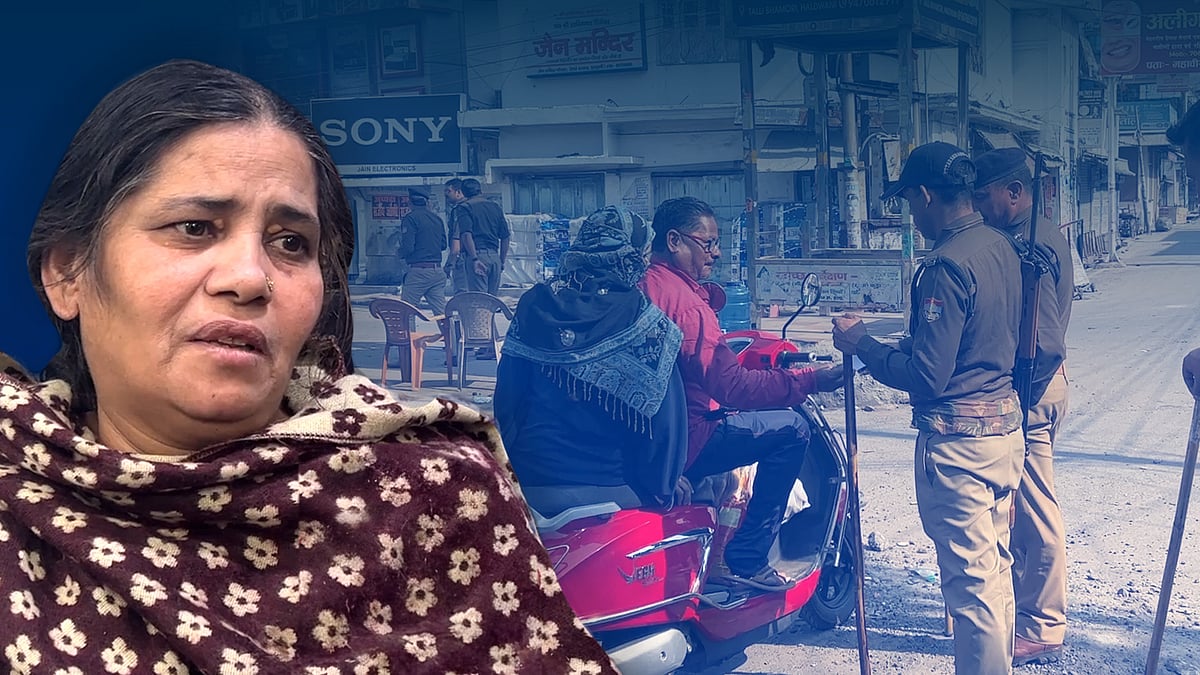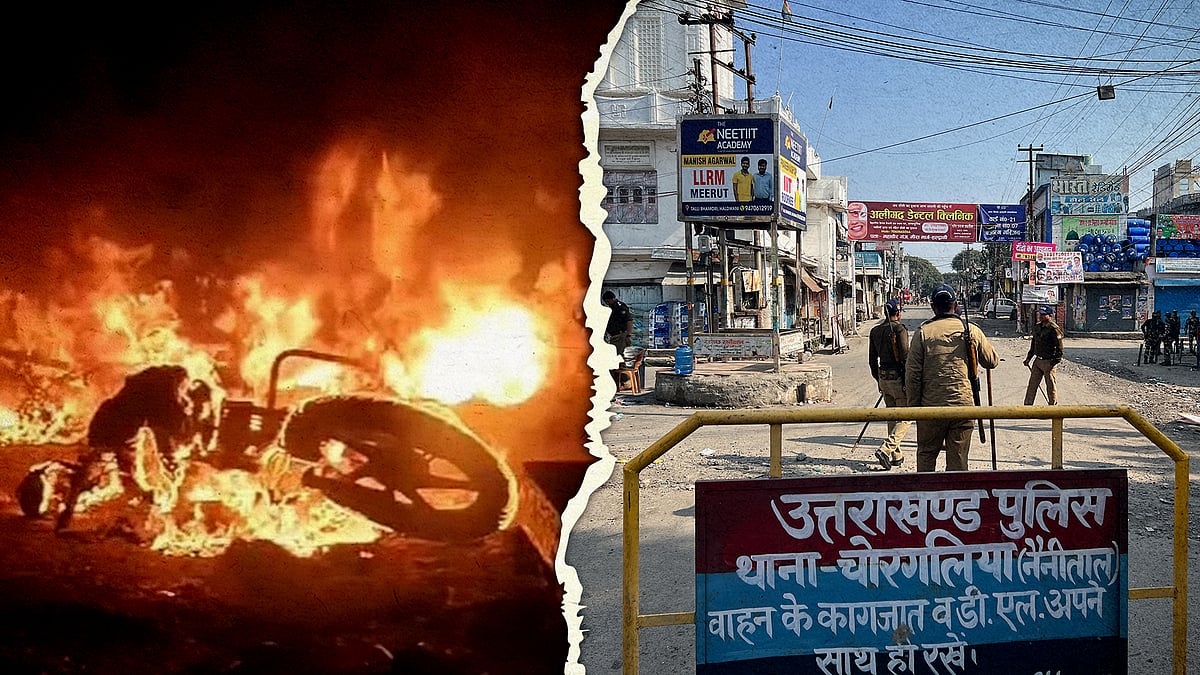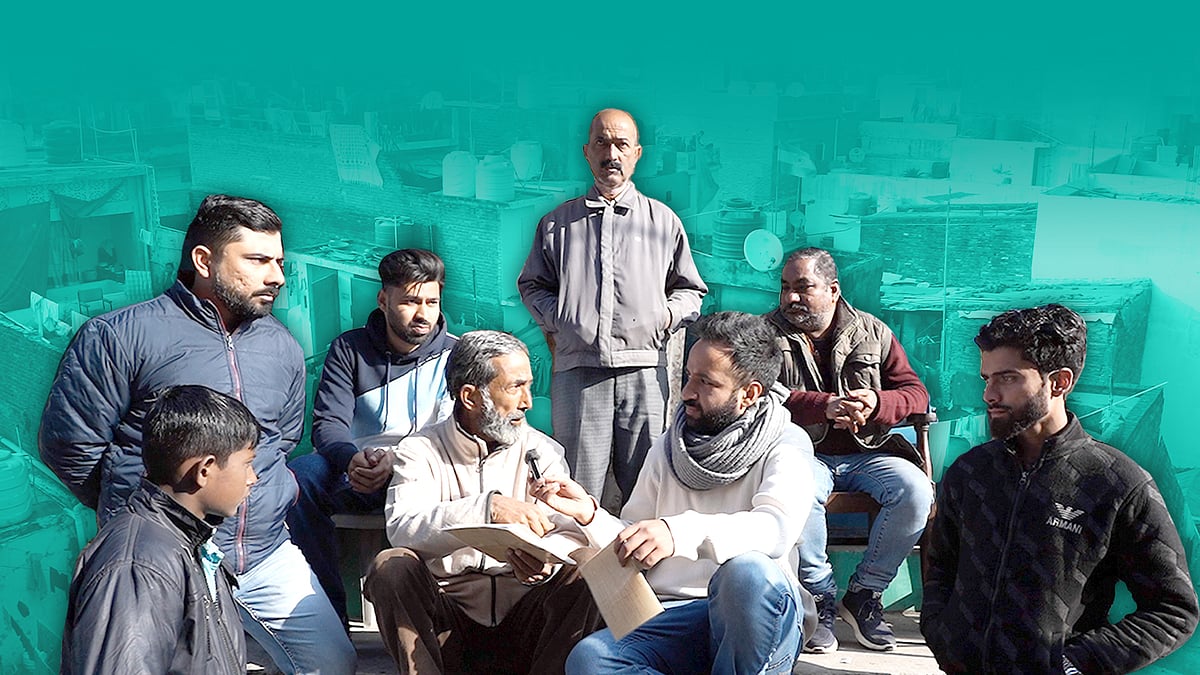In Haldwani clash, photojournalist ‘nearly killed’, mob asks reporters to ‘show video footage’
At least 10 journalists encountered an angry mob in Haldwani on February 8.
As tensions flared up in Haldwani’s Banbhoolpura between locals and police officials after the demolition of a mosque and a madrasa on February 8, Sanjay Kanera, a 48-year-old photojournalist with newspaper Amrit Vichar, “nearly died” in mob violence.
Kanera, who was at the site to report on the demolition, told Newslaundry that his camera was broken, he was pelted with stones, assaulted with lathis and firearms, and attacked by a “sharp object on the head”. He fractured the fingers on his left hand and was treated for severe injuries on head and chest at the ICU of Haldwani’s Sushila Tiwari Government Hospital.
The photojournalist said as he told the mob he was “from the media”, they became “more aggressive”.
He wasn’t the only one. Of the more than 40 journalists gathered at Banbhoolpura to report on the demolition, at least 10 of them told Newslaundry they encountered an angry mob.
Dainik Jagran’s Rajendra Singh Bisht, who was also attacked, sustained minor injuries before some locals “gave him refuge in a nearby mosque”, Kanera told Newslaundry.
As many as six people died in the clash that ensued between locals and the police, and dozens of police officers were injured.
Meanwhile, the bikes of at least 12 reporters and two photojournalists, parked near the Banbhoolpura police station, were burned down. At least three of these journalists work with Amrit Vichar, three each with Amar Ujala and Hindustan, two with Dainik Jagran, and one each with India News National, Network 18, and Uttarakhand-based Top Ki Khabar, respectively.
None of the media houses, except India News National, published any statement or news on the “targeting” of journalists, but as many as five journalists submitted a written application about the incidents to Nainital SSP Prahlad Narayan Meena. No FIR has been registered so far.
Newslaundry has seen the submissions of the journalists, and also reached out to the SSP over the matter. This report will be updated on receiving his response.
Speaking to Newslaundry, journalists said the mob identified them by their identity cards, and probed about the video footage recorded by them.
Yogesh Sharma, a journalist with India News National, who was also “targeted”, said the mob “wanted to ensure that the video footage is not transmitted, so it is not used against them”.
A Banbhoolpura resident, on condition of anonymity, told Newslaundry, “The attack on journalists is wrong, but locals were afraid that the media would only show the mob and not the police brutality”, and were frustrated over many TV channels “demonising Muslims”.
Sharma, who was also allegedly mobbed by “over 50 people”, was asked by them to show the footage he had recorded. “They checked our phones to see what kind of videos we had shot. They accused us of targeting them in the news. After a lot of back and forth, they let us go.”
Shailendra Sharma, a journalist with a prominent TV channel, said he was “safe from the mob” as he was not wearing a press card. He said two of his colleagues were identified by the camera bags they were carrying as it featured the name of their media house. Both of them were “stopped by the mob”, and told that they “show Muslims in a bad light”.
Another journalist, Sameer Bisaria, told Newslaundry that he was unharmed “because he was not wearing an identity card”.
What really unfolded at Banbhoolpur?
On February 8, as news of the municipal corporation’s action spread, journalists began pouring into the otherwise little-known Banbhoolpur. By about 4 pm, local journalists had reached the locality.
An hour later, the police and corporation officials arrived to begin the demolition of the mosque and madrasa. By now, “thousands of people had gathered near the two structures to block the roads,” Kanera told Newslaundry. “The atmosphere was really tense.”
The corporation’s action came despite the matter being subjudice.
On January 30, the corporation sent a notice about the demolition to Abdul Malik, whose family has been maintaining the mosque for generations. A week later, Abdul’s wife, Safia Malik, moved the Uttarakhand High Court, seeking interim relief against the demolition. The court listed the matter on May 10.
“The moment the police and corporation reached the site, people started shouting Allah-o-Akbar, and began pushing the barricades set up by the police,” claimed Shailendra Sharma. He said women and children also came forward “to protect the mosque and madrasa. They came and sat in the open area near the structures to stop the authorities from entering.”
The journalist said as the police forcefully removed the people, including children, “locals started pelting stones.”
One of the journalists, who did not want to be identified, said the situation “worsened when JCBs entered”. “Hundreds of people surrounded the JCB, and some even climbed on to it to stop it from moving forward”.
The journalist said police forcefully pushed people back to make way for the JCB. “And the moment the demolition started, protestors went out of control. They were a frenzied mob, raining stones on the police. After that, no one stepped back, neither the mob nor the government officials.”
The mob eventually started setting police vehicles on fire, claimed Yogesh Sharma.
Amid the clash between the police and the mob, Kanera and Bisht hid behind a car where two police officers were also hiding for safety.
Kanera said the mob spotted the cops and began hurling stones at them. “Eventually, we too were exposed to them, and we were also pelted with stones.” He told Newslaundry, as they told the mob they were “from the media”, someone shouted, “inko to aur maaro,” loosely translating to “hit them harder”.
While the crowd removed the helmet Kanera was wearing to protect himself “and kept pelting stones at him”, a few locals rescued Bisht and “took him to a nearby mosque for refuge,” Kanera said. The photojournalist then ran towards his bike and started it despite its petrol pipe being snapped by the mob.
Kanera said he had “no option”. But before he could escape, a few locals “pulled at his camera bag” and threw him off his bike. “First, they snatched my phone, my smart watch, and rings. Then, they assaulted me with a firearm, hit my head with a sharp object, and thrashed me with lathis. Blood began oozing out and I fell on the ground. But they didn’t stop, they hit me, and kicked me until they had poured out all their frustration. And then they left.” The mob also set his bike on fire.
The photojournalist was eventually taken to a nearby clinic by some locals. “I thought I was about to die when I was rescued.”
‘Tipping point’ for Muslims, ‘trust deficit’
The attack on reporters “came as no surprise”, Kanera told Newslaundry. He said Haldwani had never witnessed communal riots in the past, but the mosque and madrasa’s demolition was the “tipping point”.
“Haldwani had never witnessed communal violence, not even when the Babri Masjid was razed. Muslims here were calm even after the Uniform Civil Code was passed, or when Hindutva outfits took out rallies to celebrate the Ram temple inauguration in Ayodhya,” said Kanera.
He added the Muslim community is “being targeted on a daily basis. And I believe this was their tipping point. These are the ramifications of extreme polarisation in our society.”
Newslaundry had earlier reported how a section of the media had demonised Muslims of Haldwani, referring to them as “land jihadis”, “tukde tukde gang”, “Rohingya” and “terrorists”, over an eviction order against nearly 4,000 families in Banbhoolpura in January last year. A resident of the locality had then told Newslaundry, “We helped these reporters with their stories and provided them with all information from the ground but we were upset and furious when the same reporters portrayed us as terrorists and land jihadis on prime time show.”
The photojournalist said that the media “should be unbiased, that’s only when it can tell the truth.” “If I was targeted by a particular community, I was also saved by them. For me, the two locals who had come to save my life were angels. Hate is destructive.”
Shailendra Sharma blamed the violence against journalists on the “trust deficit” among the media, government, and the minority community.
He said the national media’s reportage on the issue was “not good”. “The reportage lacked [depth]. When such a thing [violence] happens, field reporters bear the brunt especially at a time when the national media is obsessed with debates on Hindu-Muslim and communal issues,” said Sharma, adding that “maybe, the mob did not intend to kill journalists, but they wanted to ensure that the video footage is not transmitted so it is not used against them”.
On the government’s role, the TV journalist said there was no hurry to demolish the mosque and the madrasa. In the past few years, a “lot of mazaars have been demolished”, but there were no prominent protests against them, he claimed.
General elections are around the corner, and Newslaundry and The News Minute have ambitious plans together. Choose an election project you would like to support and power our journalism. Click here.
This report has been published with AI assistance.
 In ‘crackdown’ after Haldwani violence, 18-year-old with fractured skull
In ‘crackdown’ after Haldwani violence, 18-year-old with fractured skull From job aspirant to construction worker: The 5 dead in Haldwani so far
From job aspirant to construction worker: The 5 dead in Haldwani so far ‘Does this look like encroachment?’: In Haldwani, relief after SC order, and disappointment
‘Does this look like encroachment?’: In Haldwani, relief after SC order, and disappointment ‘They called us terrorists, land jihadis’: Why Haldwani protesters are angry with ‘godi media’
‘They called us terrorists, land jihadis’: Why Haldwani protesters are angry with ‘godi media’